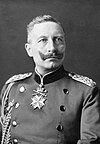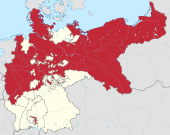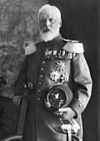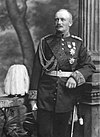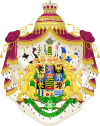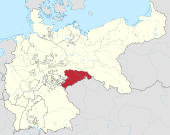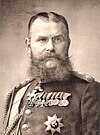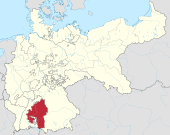List of German monarchs in 1918
| German Empire | |
|---|---|
 Imperial standard of the German Emperor (1871–1918) | |
| Preceded by | Kingdom of Prussia |
| Followed by | Abolished 1918 |
The term German Empire (Deutsches Kaiserreich) commonly refers to Germany, from its foundation as a unified nation-state on 18 January 1871, until the abdication of its last Kaiser, Wilhelm II, on November 9, 1918. Germans, when referring to the Reich in this period under the Kaisers, 1871 to 1918, typically use the term Kaiserreich.[1]
Federal prince (Bundesfürst) was the generic term for the royal heads of state (monarchs) of the various states making up the German Empire. The empire was a federal state, with its constituent states remaining sovereign states. In total, there were 22 federal princes of the German Empire and additionally three republican heads of state and the steward of the imperial territory ruled by Alsace-Lorraine. The states became part of the Kaiserreich by an 1871 treaty. The Kaiser as head of the empire was granted the title German Emperor (the style "Emperor of Germany" being deliberately avoided), and was simultaneously a federal prince as King of Prussia, the sovereign of its largest federal state. Of the princely heads of state, 4 held the title King (König) (the Kings of Prussia, Bavaria, Saxony, and Württemberg), 6 held the title Grand Duke (Großherzog), 5 held the title Duke (Herzog), and 7 held the title Prince (i.e. Sovereign Prince, Fürst).
Following the abdication of Wilhelm II on 9 November 1918 and German Revolution of 1918–19, the German nobility and royalty as legally defined classes were abolished on 11 August 1919 with the promulgation of the Weimar Constitution, under which all Germans were made equal before the law, and the legal rights and privileges, and all following German Houses, titles, insignia and ranks of nobility were abolished.
The list does not include local rulers in German colonies such as Yuhi V of Rwanda, Mwambutsa IV of Burundi and Aweida of Nauru.
German Emperor (1918)[edit]
| Emperor | Styles | Empress | Symbols | German Empire 1871 – 1918 |
|---|---|---|---|---|
 1859 – 1941 |
His Imperial and Royal Majesty The German Emperor, King of Prussia Wilhelm II Her Imperial and Royal Majesty The German Empress, Queen of Prussia Augusta Victoria |
 1858 – 1921 |
House of Hohenzollern  1871 – 1918 |
Kingdoms Prussia, Bavaria, Saxony, Württemberg Grand Duchies Baden, Hesse, Mecklenburg-Schwerin, Mecklenburg-Strelitz, Oldenburg, Saxe-Weimar-Eisenach Duchies Anhalt, Brunswick, Saxe-Altenburg, Saxe-Coburg and Gotha, Saxe-Meiningen Principalities Lippe, Reuss, junior line, Reuss, senior line, Schaumburg-Lippe, Schwarzburg-Rudolstadt, Schwarzburg-Sondershausen, Waldeck-Pyrmont Free Hanseatic cities Bremen, Hamburg, Lübeck Imperial territory (Reichsland) Alsace-Lorraine |
Kings and Kingdoms (1918)[edit]
Grand Dukes and Grand Duchies (1918)[edit]
| Ruler | Title | Arms – Flag | House – State | Location | Spouse – Children | |||||||||||||||||||||||||||||||||||||||||||||||||||||||||||||||||||||||||||||||||||||||||||||||||||||||||||||||||||||||||||||||||||||||||||||||||||||||||||||||||||||||||||||||||||||||||||||||||||||||||||||||||||||||||||||||||||||||||||||||||||||||||||||||||||||||||||||||||||||||||||||||||||||||||
|---|---|---|---|---|---|---|---|---|---|---|---|---|---|---|---|---|---|---|---|---|---|---|---|---|---|---|---|---|---|---|---|---|---|---|---|---|---|---|---|---|---|---|---|---|---|---|---|---|---|---|---|---|---|---|---|---|---|---|---|---|---|---|---|---|---|---|---|---|---|---|---|---|---|---|---|---|---|---|---|---|---|---|---|---|---|---|---|---|---|---|---|---|---|---|---|---|---|---|---|---|---|---|---|---|---|---|---|---|---|---|---|---|---|---|---|---|---|---|---|---|---|---|---|---|---|---|---|---|---|---|---|---|---|---|---|---|---|---|---|---|---|---|---|---|---|---|---|---|---|---|---|---|---|---|---|---|---|---|---|---|---|---|---|---|---|---|---|---|---|---|---|---|---|---|---|---|---|---|---|---|---|---|---|---|---|---|---|---|---|---|---|---|---|---|---|---|---|---|---|---|---|---|---|---|---|---|---|---|---|---|---|---|---|---|---|---|---|---|---|---|---|---|---|---|---|---|---|---|---|---|---|---|---|---|---|---|---|---|---|---|---|---|---|---|---|---|---|---|---|---|---|---|---|---|---|---|---|---|---|---|---|---|---|---|---|---|---|---|---|---|---|---|---|---|---|---|---|---|---|---|---|---|---|---|---|---|---|---|---|---|---|---|---|---|---|---|---|---|---|---|---|---|

|
Grand Duke Friedrich II 1857 – 1928 |
 
|
House of Zähringen C.10th – 1918 Grand Duchy of Baden 1806 – 1918 |
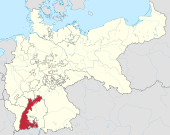
|
Spouse: (1) Princess Hilda of Nassau | |||||||||||||||||||||||||||||||||||||||||||||||||||||||||||||||||||||||||||||||||||||||||||||||||||||||||||||||||||||||||||||||||||||||||||||||||||||||||||||||||||||||||||||||||||||||||||||||||||||||||||||||||||||||||||||||||||||||||||||||||||||||||||||||||||||||||||||||||||||||||||||||||||||||||
| ||||||||||||||||||||||||||||||||||||||||||||||||||||||||||||||||||||||||||||||||||||||||||||||||||||||||||||||||||||||||||||||||||||||||||||||||||||||||||||||||||||||||||||||||||||||||||||||||||||||||||||||||||||||||||||||||||||||||||||||||||||||||||||||||||||||||||||||||||||||||||||||||||||||||||||||

|
Grand Duke Ernest Louis 1868 – 1937 |
 
|
House of Hesse-Darmstadt 1806 – 1918 Grand Duchy of Hesse 1806 – 1918 |
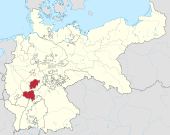
|
Spouse: (1) Victoria Melita of Saxe-Coburg and Gotha (2) Eleonore of Solms-Hohensolms-Lich Children: | |||||||||||||||||||||||||||||||||||||||||||||||||||||||||||||||||||||||||||||||||||||||||||||||||||||||||||||||||||||||||||||||||||||||||||||||||||||||||||||||||||||||||||||||||||||||||||||||||||||||||||||||||||||||||||||||||||||||||||||||||||||||||||||||||||||||||||||||||||||||||||||||||||||||||
| ||||||||||||||||||||||||||||||||||||||||||||||||||||||||||||||||||||||||||||||||||||||||||||||||||||||||||||||||||||||||||||||||||||||||||||||||||||||||||||||||||||||||||||||||||||||||||||||||||||||||||||||||||||||||||||||||||||||||||||||||||||||||||||||||||||||||||||||||||||||||||||||||||||||||||||||
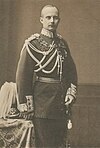
|
Grand Duke and Regent Friedrich Franz IV 1882 – 1945 |
 
|
House of Mecklenburg-Schwerin 1131 – 1918 Grand Duchy of Mecklenburg-Schwerin 1815 – 1918 Grand Duchy of Mecklenburg-Strelitz (Regent, 1918) |
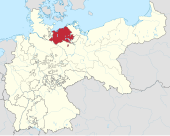 
|
Spouse: (1) Alexandra of Hanover and Cumberland Children: | |||||||||||||||||||||||||||||||||||||||||||||||||||||||||||||||||||||||||||||||||||||||||||||||||||||||||||||||||||||||||||||||||||||||||||||||||||||||||||||||||||||||||||||||||||||||||||||||||||||||||||||||||||||||||||||||||||||||||||||||||||||||||||||||||||||||||||||||||||||||||||||||||||||||||
| ||||||||||||||||||||||||||||||||||||||||||||||||||||||||||||||||||||||||||||||||||||||||||||||||||||||||||||||||||||||||||||||||||||||||||||||||||||||||||||||||||||||||||||||||||||||||||||||||||||||||||||||||||||||||||||||||||||||||||||||||||||||||||||||||||||||||||||||||||||||||||||||||||||||||||||||

|
Grand Duke Friedrich August II 1852 – 1931 |
  |
House of Holstein-Gottorp (Oldenburg) 1544 – 1918 Grand Duchy of Oldenburg 1814 – 1918 |
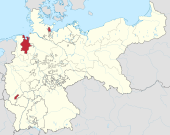
|
Spouse: (1) Princess Elisabeth Anna of Prussia, (2) Duchess Elisabeth Alexandrine of Mecklenburg-Schwerin Children: | |||||||||||||||||||||||||||||||||||||||||||||||||||||||||||||||||||||||||||||||||||||||||||||||||||||||||||||||||||||||||||||||||||||||||||||||||||||||||||||||||||||||||||||||||||||||||||||||||||||||||||||||||||||||||||||||||||||||||||||||||||||||||||||||||||||||||||||||||||||||||||||||||||||||||
| ||||||||||||||||||||||||||||||||||||||||||||||||||||||||||||||||||||||||||||||||||||||||||||||||||||||||||||||||||||||||||||||||||||||||||||||||||||||||||||||||||||||||||||||||||||||||||||||||||||||||||||||||||||||||||||||||||||||||||||||||||||||||||||||||||||||||||||||||||||||||||||||||||||||||||||||
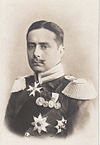
|
Grand Duke Wilhelm Ernest 1876 – 1923 |
 
|
House of Saxe-Weimar-Eisenach 1741 – 1918 Grand Duchy of Saxe-Weimar-Eisenach 1809 – 1920 |
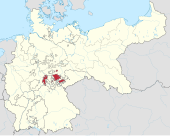
|
Spouse: (1) Princess Caroline Reuss of Greiz, (2) Princess Feodora of Saxe-Meiningen Children: | |||||||||||||||||||||||||||||||||||||||||||||||||||||||||||||||||||||||||||||||||||||||||||||||||||||||||||||||||||||||||||||||||||||||||||||||||||||||||||||||||||||||||||||||||||||||||||||||||||||||||||||||||||||||||||||||||||||||||||||||||||||||||||||||||||||||||||||||||||||||||||||||||||||||||
| ||||||||||||||||||||||||||||||||||||||||||||||||||||||||||||||||||||||||||||||||||||||||||||||||||||||||||||||||||||||||||||||||||||||||||||||||||||||||||||||||||||||||||||||||||||||||||||||||||||||||||||||||||||||||||||||||||||||||||||||||||||||||||||||||||||||||||||||||||||||||||||||||||||||||||||||
Dukes and Duchies (1918)[edit]
| Ruler | Title | Arms – Flag | House – State | Location | Spouse – Children | |||||||||||||||||||||||||||||||||||||||||||||||||||||||||||||||||||||||||||||||||||||||||||||||||||||||||||||||||||||||||||||||||||||||||||||||||||||||||||||||||||||||||||||||||||||||||||||||||||||||||||||||||||||||||||||||||||||||||||||||||||||||||||||||||||||||||||||||||||||||||||||||||||||||||
|---|---|---|---|---|---|---|---|---|---|---|---|---|---|---|---|---|---|---|---|---|---|---|---|---|---|---|---|---|---|---|---|---|---|---|---|---|---|---|---|---|---|---|---|---|---|---|---|---|---|---|---|---|---|---|---|---|---|---|---|---|---|---|---|---|---|---|---|---|---|---|---|---|---|---|---|---|---|---|---|---|---|---|---|---|---|---|---|---|---|---|---|---|---|---|---|---|---|---|---|---|---|---|---|---|---|---|---|---|---|---|---|---|---|---|---|---|---|---|---|---|---|---|---|---|---|---|---|---|---|---|---|---|---|---|---|---|---|---|---|---|---|---|---|---|---|---|---|---|---|---|---|---|---|---|---|---|---|---|---|---|---|---|---|---|---|---|---|---|---|---|---|---|---|---|---|---|---|---|---|---|---|---|---|---|---|---|---|---|---|---|---|---|---|---|---|---|---|---|---|---|---|---|---|---|---|---|---|---|---|---|---|---|---|---|---|---|---|---|---|---|---|---|---|---|---|---|---|---|---|---|---|---|---|---|---|---|---|---|---|---|---|---|---|---|---|---|---|---|---|---|---|---|---|---|---|---|---|---|---|---|---|---|---|---|---|---|---|---|---|---|---|---|---|---|---|---|---|---|---|---|---|---|---|---|---|---|---|---|---|---|---|---|---|---|---|---|---|---|---|---|---|---|

|
Duke Joachim Ernst 1901 – 1947 |
 
|
House of Ascania 1036 – 1918 Duchy of Anhalt 1863 – 1918 |
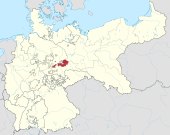
|
Spouse: (1) Elisabeth Strickrodt, (2) Editha Marwitz von Stephani Children: | |||||||||||||||||||||||||||||||||||||||||||||||||||||||||||||||||||||||||||||||||||||||||||||||||||||||||||||||||||||||||||||||||||||||||||||||||||||||||||||||||||||||||||||||||||||||||||||||||||||||||||||||||||||||||||||||||||||||||||||||||||||||||||||||||||||||||||||||||||||||||||||||||||||||||
| ||||||||||||||||||||||||||||||||||||||||||||||||||||||||||||||||||||||||||||||||||||||||||||||||||||||||||||||||||||||||||||||||||||||||||||||||||||||||||||||||||||||||||||||||||||||||||||||||||||||||||||||||||||||||||||||||||||||||||||||||||||||||||||||||||||||||||||||||||||||||||||||||||||||||||||||

|
Duke Ernest Augustus 1887 – 1953 |
 
|
House of Hanover 1635 – 1918 Duchy of Brunswick 1815 – 1918 |
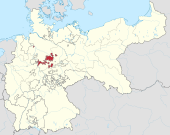
|
Spouse: (1) Princess Victoria Louise of Prussia Children: | |||||||||||||||||||||||||||||||||||||||||||||||||||||||||||||||||||||||||||||||||||||||||||||||||||||||||||||||||||||||||||||||||||||||||||||||||||||||||||||||||||||||||||||||||||||||||||||||||||||||||||||||||||||||||||||||||||||||||||||||||||||||||||||||||||||||||||||||||||||||||||||||||||||||||
| ||||||||||||||||||||||||||||||||||||||||||||||||||||||||||||||||||||||||||||||||||||||||||||||||||||||||||||||||||||||||||||||||||||||||||||||||||||||||||||||||||||||||||||||||||||||||||||||||||||||||||||||||||||||||||||||||||||||||||||||||||||||||||||||||||||||||||||||||||||||||||||||||||||||||||||||

|
Duke Ernst II 1871 – 1955 |
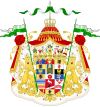 
|
House of Wettin 900 – 1918 Duchy of Saxe-Altenburg 1826 – 1918 |
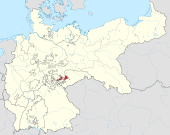
|
Spouse: (1) Princess Adelaide of Schaumburg-Lippe, (2) Maria Triebel (morganatic) Children: | |||||||||||||||||||||||||||||||||||||||||||||||||||||||||||||||||||||||||||||||||||||||||||||||||||||||||||||||||||||||||||||||||||||||||||||||||||||||||||||||||||||||||||||||||||||||||||||||||||||||||||||||||||||||||||||||||||||||||||||||||||||||||||||||||||||||||||||||||||||||||||||||||||||||||
| ||||||||||||||||||||||||||||||||||||||||||||||||||||||||||||||||||||||||||||||||||||||||||||||||||||||||||||||||||||||||||||||||||||||||||||||||||||||||||||||||||||||||||||||||||||||||||||||||||||||||||||||||||||||||||||||||||||||||||||||||||||||||||||||||||||||||||||||||||||||||||||||||||||||||||||||

|
Duke Charles Edward 1884 – 1954 |
 
|
House of Saxe-Coburg and Gotha 1826 – 1918 Duchy of Saxe-Coburg Gotha 1826 – 1918 |
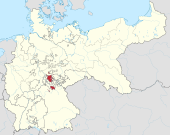
|
Spouse: (1) Princess Victoria Adelaide of Schleswig-Holstein Children: | |||||||||||||||||||||||||||||||||||||||||||||||||||||||||||||||||||||||||||||||||||||||||||||||||||||||||||||||||||||||||||||||||||||||||||||||||||||||||||||||||||||||||||||||||||||||||||||||||||||||||||||||||||||||||||||||||||||||||||||||||||||||||||||||||||||||||||||||||||||||||||||||||||||||||
| ||||||||||||||||||||||||||||||||||||||||||||||||||||||||||||||||||||||||||||||||||||||||||||||||||||||||||||||||||||||||||||||||||||||||||||||||||||||||||||||||||||||||||||||||||||||||||||||||||||||||||||||||||||||||||||||||||||||||||||||||||||||||||||||||||||||||||||||||||||||||||||||||||||||||||||||

|
Duke Bernhard III 1851 – 1928 |
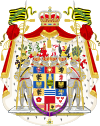 
|
House of Saxe-Meiningen (Wettin) 1680 – 1918 Duchy of Saxe-Meiningen 1680 – 1918 |
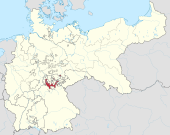
|
Spouse: (1) Princess Charlotte of Prussia Children: | |||||||||||||||||||||||||||||||||||||||||||||||||||||||||||||||||||||||||||||||||||||||||||||||||||||||||||||||||||||||||||||||||||||||||||||||||||||||||||||||||||||||||||||||||||||||||||||||||||||||||||||||||||||||||||||||||||||||||||||||||||||||||||||||||||||||||||||||||||||||||||||||||||||||||
| ||||||||||||||||||||||||||||||||||||||||||||||||||||||||||||||||||||||||||||||||||||||||||||||||||||||||||||||||||||||||||||||||||||||||||||||||||||||||||||||||||||||||||||||||||||||||||||||||||||||||||||||||||||||||||||||||||||||||||||||||||||||||||||||||||||||||||||||||||||||||||||||||||||||||||||||
Princes and Principalities (1918)[edit]
| Ruler | Title | Arms – Flag | House – State | Location | Spouse – Children | |||||||||||||||||||||||||||||||||||||||||||||||||||||||||||||||||||||||||||||||||||||||||||||||||||||||||||||||||||||||||||||||||||||||||||||||||||||||||||||||||||||||||||||||||||||||||||||||||||||||||||||||||||||||||||||||||||||||||||||||||||||||||||||||||||||||||||||||||||||||||||||||||||||||||
|---|---|---|---|---|---|---|---|---|---|---|---|---|---|---|---|---|---|---|---|---|---|---|---|---|---|---|---|---|---|---|---|---|---|---|---|---|---|---|---|---|---|---|---|---|---|---|---|---|---|---|---|---|---|---|---|---|---|---|---|---|---|---|---|---|---|---|---|---|---|---|---|---|---|---|---|---|---|---|---|---|---|---|---|---|---|---|---|---|---|---|---|---|---|---|---|---|---|---|---|---|---|---|---|---|---|---|---|---|---|---|---|---|---|---|---|---|---|---|---|---|---|---|---|---|---|---|---|---|---|---|---|---|---|---|---|---|---|---|---|---|---|---|---|---|---|---|---|---|---|---|---|---|---|---|---|---|---|---|---|---|---|---|---|---|---|---|---|---|---|---|---|---|---|---|---|---|---|---|---|---|---|---|---|---|---|---|---|---|---|---|---|---|---|---|---|---|---|---|---|---|---|---|---|---|---|---|---|---|---|---|---|---|---|---|---|---|---|---|---|---|---|---|---|---|---|---|---|---|---|---|---|---|---|---|---|---|---|---|---|---|---|---|---|---|---|---|---|---|---|---|---|---|---|---|---|---|---|---|---|---|---|---|---|---|---|---|---|---|---|---|---|---|---|---|---|---|---|---|---|---|---|---|---|---|---|---|---|---|---|---|---|---|---|---|---|---|---|---|---|---|---|---|
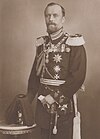
|
Prince Leopold IV 1871 – 1949 |
 
|
House of Lippe 1123 – 1918 Principality of Lippe 1123 – 1918 |

|
Spouse: (1) Princess Bertha of Hesse-Philippsthal-Barchfeld (2) Princess Anna of Ysenburg and Büdingen Children: | |||||||||||||||||||||||||||||||||||||||||||||||||||||||||||||||||||||||||||||||||||||||||||||||||||||||||||||||||||||||||||||||||||||||||||||||||||||||||||||||||||||||||||||||||||||||||||||||||||||||||||||||||||||||||||||||||||||||||||||||||||||||||||||||||||||||||||||||||||||||||||||||||||||||||
| ||||||||||||||||||||||||||||||||||||||||||||||||||||||||||||||||||||||||||||||||||||||||||||||||||||||||||||||||||||||||||||||||||||||||||||||||||||||||||||||||||||||||||||||||||||||||||||||||||||||||||||||||||||||||||||||||||||||||||||||||||||||||||||||||||||||||||||||||||||||||||||||||||||||||||||||
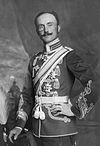
|
Prince Adolf II 1883 – 1936 |
 
|
House of Lippe 1123 – 1918 Principality of Schaumburg-Lippe 1643 – 1918 |

|
Spouse: (1) Ellen Bischoff-Korthaus (1894–1936) | |||||||||||||||||||||||||||||||||||||||||||||||||||||||||||||||||||||||||||||||||||||||||||||||||||||||||||||||||||||||||||||||||||||||||||||||||||||||||||||||||||||||||||||||||||||||||||||||||||||||||||||||||||||||||||||||||||||||||||||||||||||||||||||||||||||||||||||||||||||||||||||||||||||||||
| ||||||||||||||||||||||||||||||||||||||||||||||||||||||||||||||||||||||||||||||||||||||||||||||||||||||||||||||||||||||||||||||||||||||||||||||||||||||||||||||||||||||||||||||||||||||||||||||||||||||||||||||||||||||||||||||||||||||||||||||||||||||||||||||||||||||||||||||||||||||||||||||||||||||||||||||
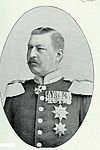
|
Prince Günther Victor 1852 – 1925 |
 
|
House of Schwarzburg 11?? – 1918 Principality of Schwarzburg-Rudolstadt 1599 – 1919 Principality of Schwarzburg-Sondershausen (1909–1920) |
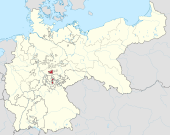 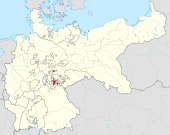
|
Spouse (1) Princess Anna Louise of Schönburg-Waldenburg | |||||||||||||||||||||||||||||||||||||||||||||||||||||||||||||||||||||||||||||||||||||||||||||||||||||||||||||||||||||||||||||||||||||||||||||||||||||||||||||||||||||||||||||||||||||||||||||||||||||||||||||||||||||||||||||||||||||||||||||||||||||||||||||||||||||||||||||||||||||||||||||||||||||||||
| ||||||||||||||||||||||||||||||||||||||||||||||||||||||||||||||||||||||||||||||||||||||||||||||||||||||||||||||||||||||||||||||||||||||||||||||||||||||||||||||||||||||||||||||||||||||||||||||||||||||||||||||||||||||||||||||||||||||||||||||||||||||||||||||||||||||||||||||||||||||||||||||||||||||||||||||
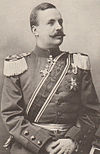
|
Prince Friedrich 1865 – 1946 |
 
|
House of Waldeck and Pyrmont 1815 – 1918 Principality of Waldeck and Pyrmont 1180 – 1918 |
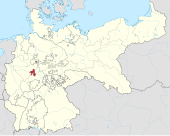
|
Spouse: (1) Princess Bathildis of Schaumburg-Lippe Children: | |||||||||||||||||||||||||||||||||||||||||||||||||||||||||||||||||||||||||||||||||||||||||||||||||||||||||||||||||||||||||||||||||||||||||||||||||||||||||||||||||||||||||||||||||||||||||||||||||||||||||||||||||||||||||||||||||||||||||||||||||||||||||||||||||||||||||||||||||||||||||||||||||||||||||
| ||||||||||||||||||||||||||||||||||||||||||||||||||||||||||||||||||||||||||||||||||||||||||||||||||||||||||||||||||||||||||||||||||||||||||||||||||||||||||||||||||||||||||||||||||||||||||||||||||||||||||||||||||||||||||||||||||||||||||||||||||||||||||||||||||||||||||||||||||||||||||||||||||||||||||||||
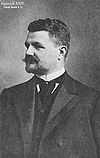
|
Prince Heinrich XXIV 1878 – 1927 |
 
|
House of Reuss (Elder Line) 1778 – 1918 Principality of Reuss-Greiz 1778 – 1918 |
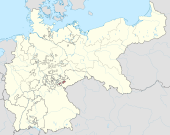
|
||||||||||||||||||||||||||||||||||||||||||||||||||||||||||||||||||||||||||||||||||||||||||||||||||||||||||||||||||||||||||||||||||||||||||||||||||||||||||||||||||||||||||||||||||||||||||||||||||||||||||||||||||||||||||||||||||||||||||||||||||||||||||||||||||||||||||||||||||||||||||||||||||||||||||
| ||||||||||||||||||||||||||||||||||||||||||||||||||||||||||||||||||||||||||||||||||||||||||||||||||||||||||||||||||||||||||||||||||||||||||||||||||||||||||||||||||||||||||||||||||||||||||||||||||||||||||||||||||||||||||||||||||||||||||||||||||||||||||||||||||||||||||||||||||||||||||||||||||||||||||||||

|
Prince Heinrich XXVII 1858 – 1928 |
 
|
House of Reuss (Younger Line) 1913 – 1918 Principality of Reuss-Gera 1806 – 1918 |
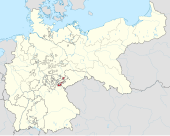
|
Spouse: (1) Princess Elise of Hohenlohe-Langenburg Children: | |||||||||||||||||||||||||||||||||||||||||||||||||||||||||||||||||||||||||||||||||||||||||||||||||||||||||||||||||||||||||||||||||||||||||||||||||||||||||||||||||||||||||||||||||||||||||||||||||||||||||||||||||||||||||||||||||||||||||||||||||||||||||||||||||||||||||||||||||||||||||||||||||||||||||
| ||||||||||||||||||||||||||||||||||||||||||||||||||||||||||||||||||||||||||||||||||||||||||||||||||||||||||||||||||||||||||||||||||||||||||||||||||||||||||||||||||||||||||||||||||||||||||||||||||||||||||||||||||||||||||||||||||||||||||||||||||||||||||||||||||||||||||||||||||||||||||||||||||||||||||||||
November Revolution abdications[edit]
Throughout the month of November 1918, all 22 monarchs within the German Empire were either forced to abdicate, or stepped down of their own accord. Duke Ernest Augustus of Brunswick was the first to do so on 8 November. The next day, the Emperor and King of Prussia Wilhelm II, went into exile in the Netherlands, and his abdication (which he would not officially confirm until 28 November, see below) was announced by his Chancellor and Prussian Minister President Maximilian of Baden. MSDP co-chairman Philipp Scheidemann proclaimed the new "German Republic" from the Reichstag building to gathered crowds, while two hours thereafter Spartacist leader Karl Liebknecht proclaimed the "Free Socialist Republic of Germany" at Berlin Palace. Neither proclamation of the republic was constitutional, and the political situation remained chaotic for several more months, with a short civil war between radical leftist revolutionaries and the more moderate post-imperial social democrat government that would emerge victorious and form the Weimar Republic. Nevertheless, the proclamations and Wilhelm II's abdication triggered a powerful domino effect: the same day a number of other princes stepped down, and within a week most monarchs in Germany had followed suit. The last to abdicate was King William II of Württemberg on 30 November 1918.
| Date | Title and name | State |
|---|---|---|
| 9 November 1918 | Emperor Wilhelm II | German Empire |
| 9 November 1918 | King Wilhelm II | Kingdom of Prussia |
| 13 November 1918 | King Ludwig III | Kingdom of Bavaria |
| 13 November 1918 | King Frederick Augustus III | Kingdom of Saxony |
| 30 November 1918 | King William II | Kingdom of Württemberg |
| 22 November 1918 | Grand Duke Frederick II | Grand Duchy of Baden |
| 9 November 1918 | Grand Duke Ernest Louis | Grand Duchy of Hesse |
| 14 November 1918 | Grand Duke Frederick Francis IV | Grand Duchy of Mecklenburg-Schwerin |
| 14 November 1918 | Regent Frederick Francis | Grand Duchy of Mecklenburg-Strelitz |
| 11 November 1918 | Grand Duke Frederick Augustus II | Grand Duchy of Oldenburg |
| 9 November 1918 | Grand Duke William Ernest | Grand Duchy of Saxe-Weimar-Eisenach |
| 12 November 1918 | Duke Joachim Ernst | Duchy of Anhalt |
| 8 November 1918 | Duke Ernest Augustus | Duchy of Brunswick |
| 13 November 1918 | Duke Ernst II | Duchy of Saxe-Altenburg |
| 14 November 1918 | Duke Charles Edward | Duchy of Saxe-Coburg and Gotha |
| 10 November 1918 | Duke Bernhard III | Duchy of Saxe-Meiningen |
| 12 November 1918 | Prince Leopold IV | Principality of Lippe |
| 15 November 1918 | Prince Adolf II | Principality of Schaumburg-Lippe |
| 22 November 1918 | Prince Günther Victor | Principalities of Schwarzburg-Rudolstadt and Schwarzburg-Sondershausen |
| 13 November 1918 | Prince Friedrich | Principality of Waldeck and Pyrmont |
| 10 November 1918 | Prince Heinrich XXIV | Principality of Reuss-Greiz |
| 11 November 1918 | Prince Heinrich XXVII | Principality of Reuss-Gera |
Imperial statement of abdication (1918)[edit]
I herewith renounce for all time claims to the throne of Prussia and to the German Imperial throne connected therewith.
At the same time I release all officials of the German Empire and of Prussia, as well as all officers, non-commissioned officers and men of the navy and of the Prussian army, as well as the troops of the federated states of Germany, from the oath of fidelity which they tendered to me as their Emperor, King and Commander-in-Chief. I expect of them that until the re-establishment of order in the German Empire they shall render assistance to those in actual power in Germany, in protecting the German people from the threatening dangers of anarchy, famine, and foreign rule. Proclaimed under our own hand and with the imperial seal attached. Amerongen, 28 November 1918. Signed WILLIAM.[2]
See also[edit]
- Abdication of Wilhelm II
- German nobility in Nazi Germany
- German Empire
- German Emperor
- History of Germany
- History of Prussia
- Hohenzollern Castle
- Crown of William II
- King in Prussia
- List of German monarchs
- Year of the Three Emperors
- List of monarchs of Prussia
- List of rulers of Saxony
- List of rulers of Württemberg
- Kings of Germany family tree
References[edit]
- ^ Harper's magazine, Volume 63. Pp. 593. While the term Reich does not literally connote an empire as has been commonly assumed by English-speaking people, the term Kaiserreich literally denotes an empire - particularly a hereditary empire led by a literal emperor, though Reich has been used in German to denote the Roman Empire because it had a weak hereditary tradition. In the case of the German Empire, the official name Deutsches Reich is properly translated as "German Realm"; under its constitution the King of Prussia, as head of state, officially "presided" over a confederation of German states, and held "the title of German Emperor" in the sense of an emperor who was German, rather than emperor of a German state.
- ^ Statement of Abdication (1918). As translated and appearing in the 1923 Source Records of the Great War, Vol. VI, edited by Charles F. Horne.
•Chisholm, Hugh, ed. (1911). . Encyclopædia Britannica. Vol. 28 (11th ed.). Cambridge University Press. pp. 667–669.

